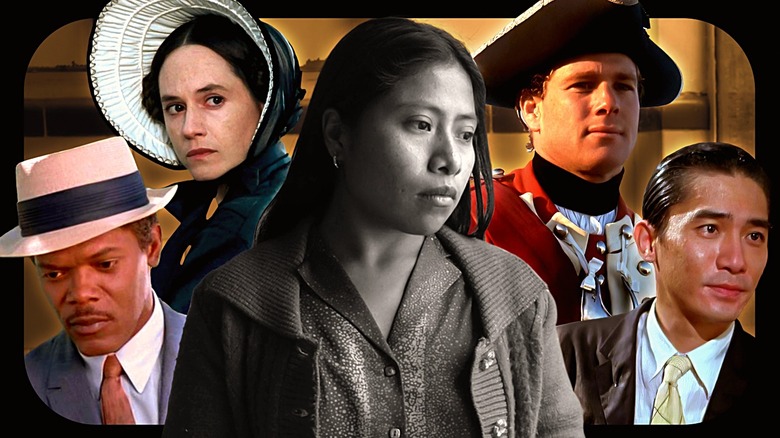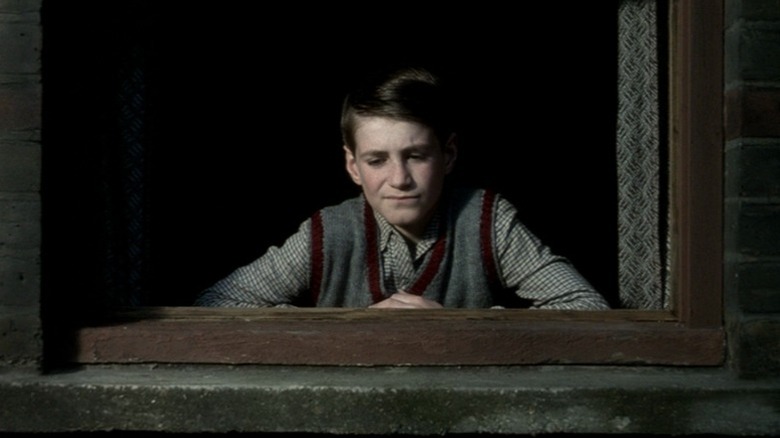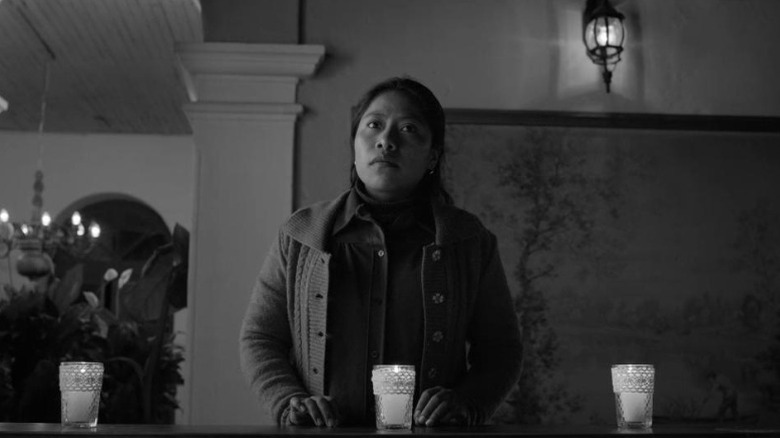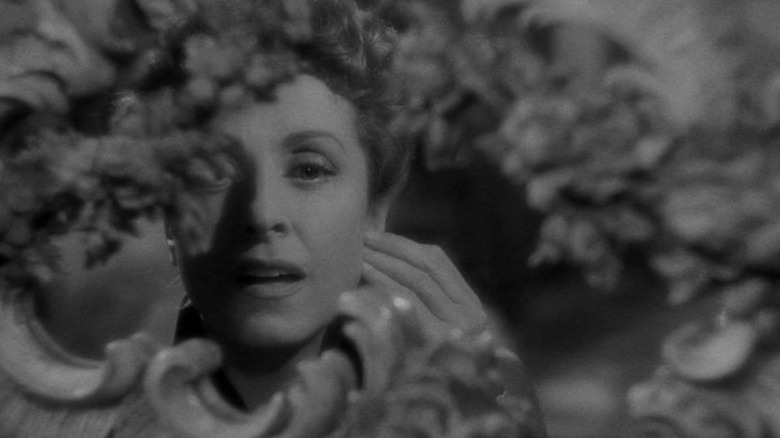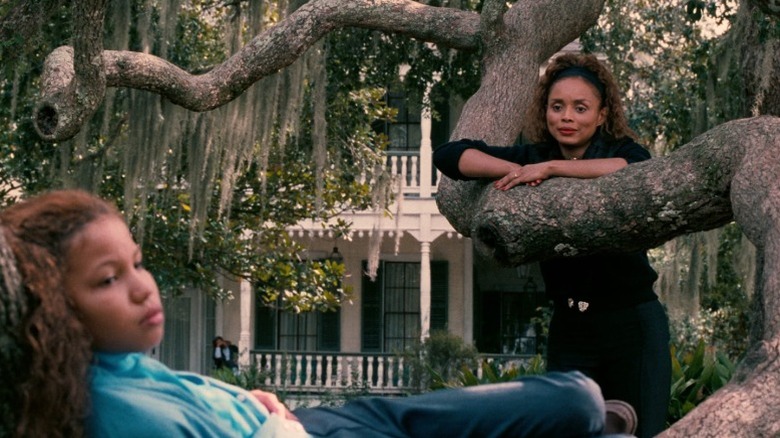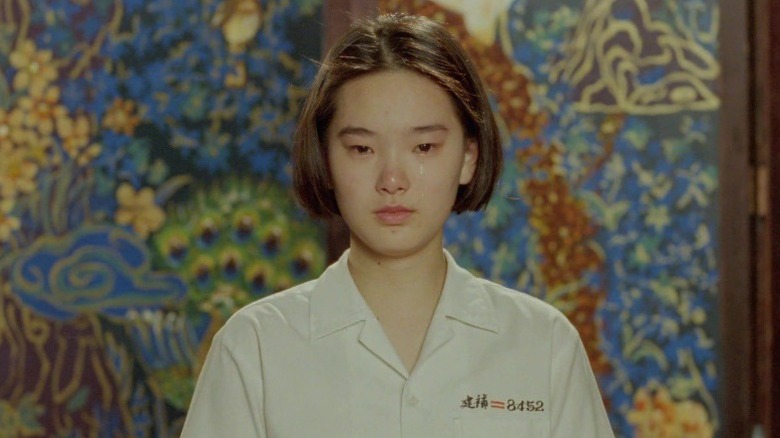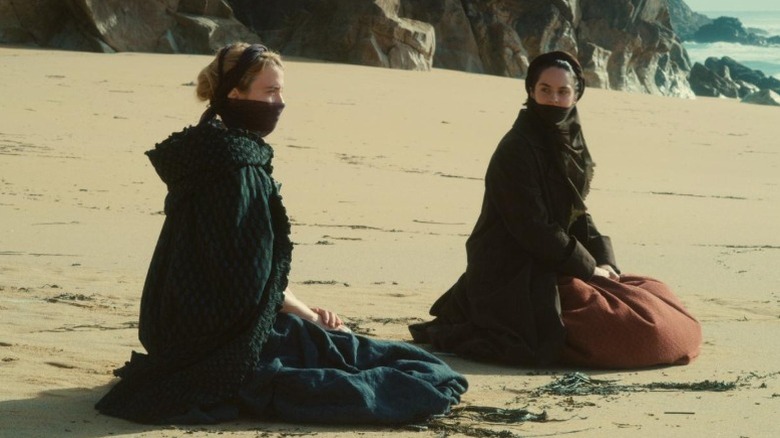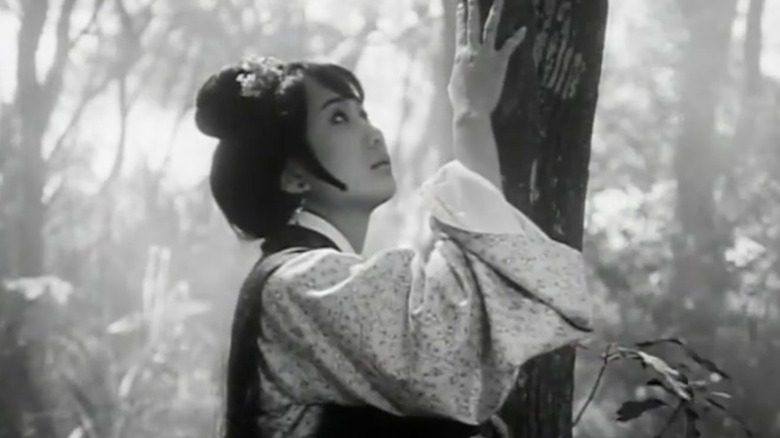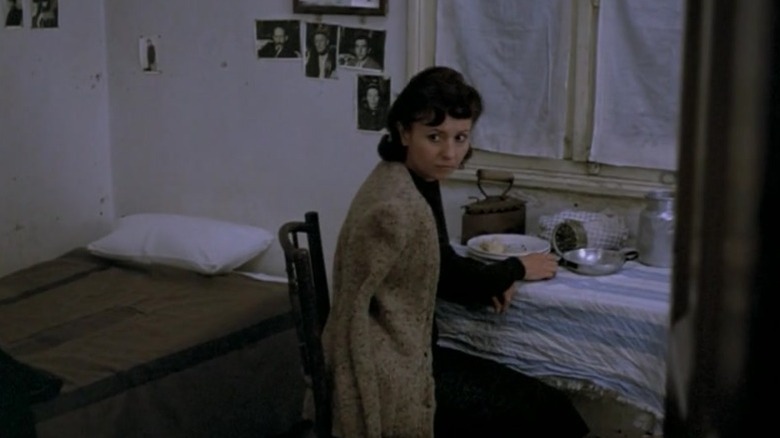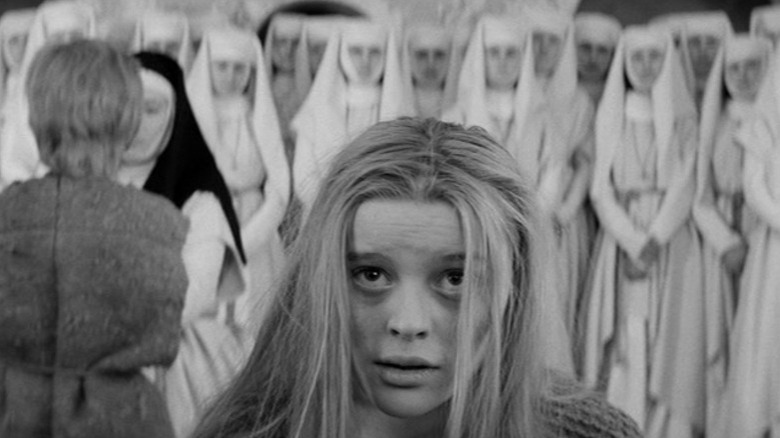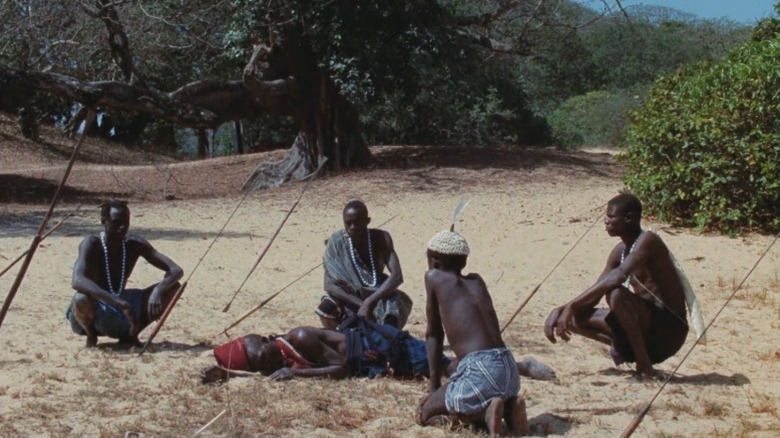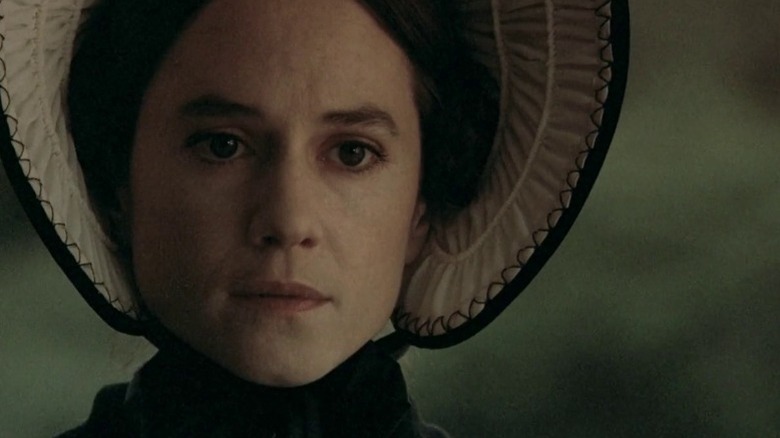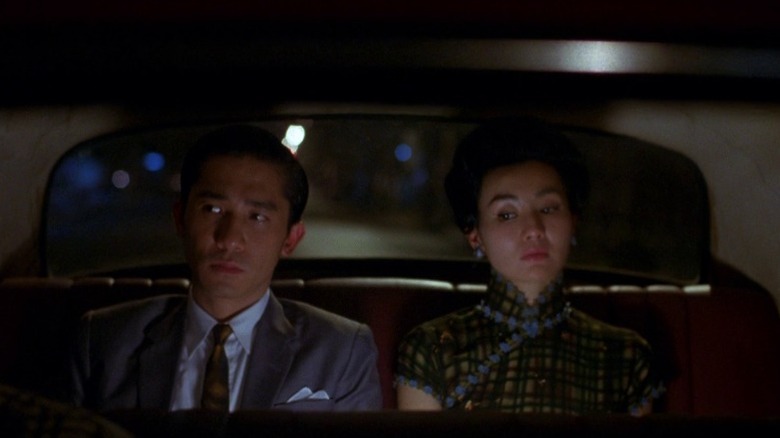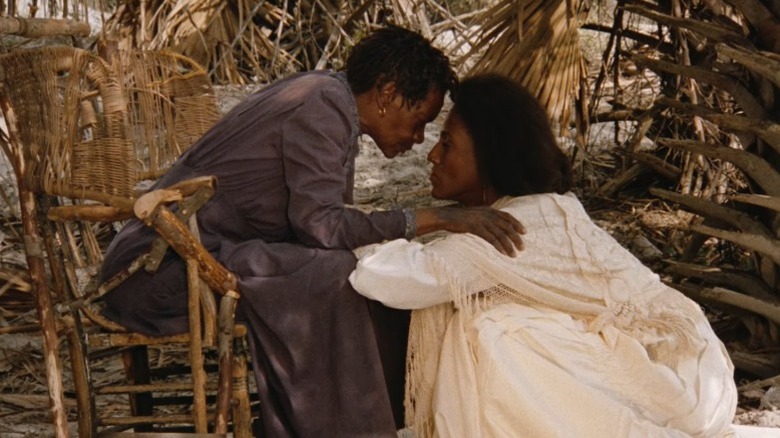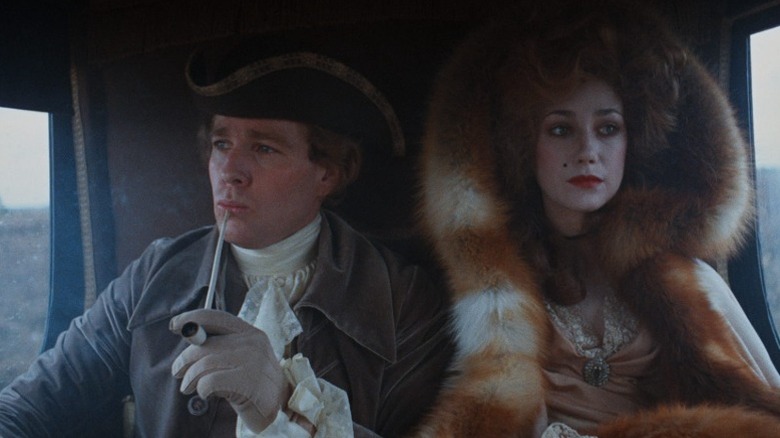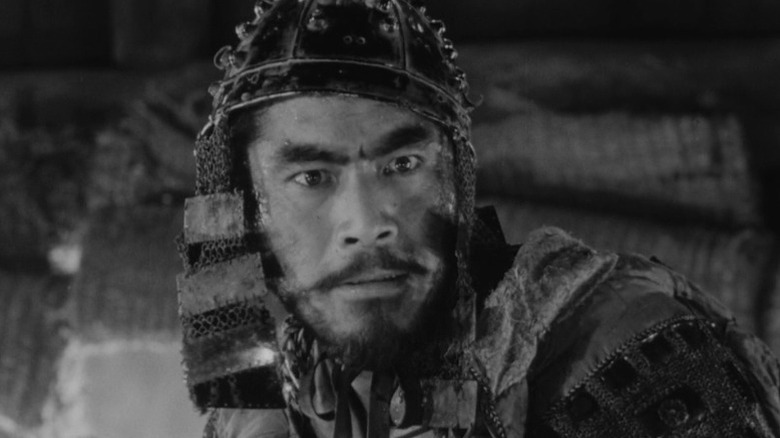The 15 Best Period Piece Movies Of All Time, Ranked
In 2010, Steve Martin, the best Oscars host of all time, wrapped up proceedings for that year's Academy Awards ceremony with a thought-provoking quip: "Ladies and gentlemen, the show is so long that 'Avatar' now takes place in the past." Mandatory Oscar self-castigation aside, it was a playful commentary on the fluidity of cinematic time, and of our own real-life time by extension: The past is ever bigger, the future is never so. Even the "Back to the Future" movies are now technically 100% set in the past.
This list speaks to that fluidity: As you scroll down this ranking of the 15 greatest period pieces in film history, you will find that some of the movies on it are older altogether than the distant pasts of other entries. Cinema has never stopped looking back, to frequently moving, eye-opening, and exhilarating effect; let us then follow suit and look back on cinema's history of depicting history.
15. The Long Day Closes
British director Terence Davis was an expert in the art of thoughtful revisitation of his own past, and, in 1992's loosely autobiographical "The Long Day Closes," he gave poetic, richly expressive life to his memories of growing up in Liverpool in the 1950s.
Following 12-year-old Bud (Leigh McCormack) as he deals with familial and religious pressures in postwar England, the movie slots into its director's invaluable treasury of historical queer experience in the U.K., also a mark of Davies' swan song "Benediction." Like many lonely gay kids past and present, Bud finds escape and validation in the wonderful world of music and movies, and builds an embattled but hopeful sense of self through the fragments of beauty he finds in the world.
It's a fluid, kaleidoscopic, unconventional portrait of place and time like few in the medium's history — by far one of the best examples ever of a filmmaker reflecting on his own relationship to cinema and to the impetus of creation. Davies' tableaux of midcentury Liverpool life are perfect because they are both elegiac and ambivalent, as gorgeously textured as they are devastatingly melancholy.
14. Roma
Speaking of filmmakers reflecting on their own personal histories, 21st century cinema has scarcely seen a more ambitious, sweeping, or complicated reckoning with an artist's biographical baggage than Alfonso Cuarón's "Roma."
A portrait of 1970s Mexico City as seen from the perspective of Cleo (Yalitza Aparicio), a Mixtec maid to an upper-middle-class white family inspired by Cuarón's own real-life nanny Liboria Rodriguez, the film is astonishing enough as a "mere" human-sized historical epic. More virtuosic than ever, the director charts a turbulent time in Mexico's political history through everyday scenes of urban life realized with the same massive technical and aesthetic prowess of "Children of Men" or "Gravity" (including Cuarón's obsession with realistic sets).
What truly makes the movie fascinating, however, is the way it embraces self-reflection, with Cuarón vividly recapturing moments of formative sentiment and honoring his love and reverence for Cleo's real-life inspiration, while openly admonishing the white family's exploitative and alienated relationship to Cleo. With help from quietly sharp writing and an extraordinary breakout performance by Aparicio, "Roma" finds an inquisitive artist not merely revisiting the past but seeking to explore and understand that in it which he previously didn't.
13. The Earrings of Madame de...
A classic of "orthodox" French film prior to the French New Wave, 1953's "The Earrings of Madame de..." became legendary for the dizzying balletic grace and formal bravado of Max Ophüls' camera. As he tells the story of a late-19th-century French noblewoman (Danielle Darrieux) who accidentally initiates a twisty chain of romantic misfortune by selling a pair of expensive earrings, Ophüls engages in some of the most advanced and dazzling long takes and tracking shots in film history, capturing Belle Époque Paris so vividly that you feel as though you're not just living it but reveling in it.
Just as incredible and a lot less extolled, however, is the brilliance of Ophüls, Annette Wademant, and Marcel Achard's screenplay, which stands as one of the greatest feats of scaffolding melodramatic construction in movie history. Not only are the story's tightly-woven turns and intrigues deeply persuasive on an emotional level, but they paint such a merciless and perceptive portrait of Parisian society in the 1890s, with all its aristocratic and sexual contradictions, that the film gets to feel rather like a necessary stepping stone to all the rebellious gusto that would come later in French cinema.
12. Eve's Bayou
There haven't been many movies like "Eve's Bayou," Kasi Lemmons' Southern Gothic masterpiece about the nooks and crannies of Creole-American life in 1960s Louisiana. And that's not just because of the film's curious, searching, still-all-too-rare focus on an unexplored section of Black American history, much as that also deserves plaudits. What Lemmons displayed in it was one of the most imaginative eyes and one of the most original voices of any debuting filmmaker in history — a conjugated understanding of storytelling and image-making that felt miraculous in 1997 and still does today.
A phenomenal cast including Samuel L. Jackson, Debbi Morgan, Lynn Whitfield, Diahann Carroll, and a 10-year-old Jurnee Smollett comes together for the movie's original but novel-rich story of the Batistes, a successful and admired Creole family contending with deep-buried secrets. Lemmons makes use of expressionistic editing and lensing to get at the shifty nature of memory and perception, yet captures her specific historical milieu with such hot, vaporous clarity that the film feels at once like a document and a waking dream.
11. A Brighter Summer Day
One of the best movies based on true stories, Edward Yang's "A Brighter Summer Day" shares with other films on this list the vivid evocation of its auteur's own childhood environment, captured in all the messy, dramatically "extraneous" detail that makes lived experience such a potent engine for period recreation.
Titled "Youth Homicide Incident On Guling Street" in Chinese, the 1991 Taiwanese film follows the raucous — and largely pointless — youth gang conflicts swirling around a Taipei night school in 1960. Protagonist Hsiao Si'r (Chang Chen) wants everything the average teenage boy wants — good grades, a girlfriend, acceptance from his family and his peers — yet the violent, repressive, and paranoid circumstances of Kuomintang-controlled post-retreat Taiwan repeatedly derail any chance he might have of leading a normal life.
If Yang's other films find him honing a singular poetry of the everyday, "A Brighter Summer Day" is the moment in his filmography in which he allows himself full, unbridled emotional tempestuousness, flitting masterfully between muted minimalism and violent action-packed melodrama over four draining yet gripping hours. It's the arguable best work from one of the greatest directors of all time.
10. Portrait of a Lady on Fire
In a lot of ways, "Portrait of a Lady on Fire" is a movie about what it's truly like to live ahead of one's time. In Céline Sciamma's apprehension, it's not a pretty thing: The inescapable siege of the historical moment corners Marianne (Noémie Merlant) and Héloise (Adèle Haenel) from all sides, trapping them in a version of being alive in the world that's by nature limited and frustrating. Yet, against all norm, they long for more — and find it in each other.
The 2019 modern classic, one of the greatest romance films of all time, follows Marianne, a late-18th-century French painter, as she's hired to paint a portrait of Héloise, a rebellious gentry woman, to facilitate her betrothal (read: sale) to a Milanese nobleman. Isolated on a remote island off the coast of Brittany, the two women lock into a playful, flirtatious, and eventually passionate rhythm as Marianne breaks down Héloise's walls by showing a genuine interest in who she is. In their few weeks together, they build a miniature paradise of love, sex, art, and companionship, accessible only to and by them. Then, they part ways, and history crests back over them like a tidal wave.
9. The Arch
Tang Shu Shuen's "The Arch" is probably the least widely-known film on this list, which is a travesty in and of itself given its sheer historical importance: Released in 1968, at a time when Hong Kong cinema was dominated by martial arts movies, it single-handedly laid the groundwork for the Hong Kong New Wave that would reach full swing only decades later. On top of that, it's a rare instance of a pre-1970 auteurist triumph from a female director, with Tang exerting full control over her radical vision.
Historical laurels aside, "The Arch" deserves more notoriety simply because it is a staggeringly wonderful movie. Following widowed feudal noblewoman Madame Tung (Lisa Lu) as she awaits the construction of an arch in her honor, Tang's psychological masterpiece charts the chaos that takes over Madame Tung's headspace when she falls in love with a younger cavalry captain (Roy Chiao). The ensuing whirlwind of lust, guilt, anger, shame, and confusion is among cinema's most original and ecstatically expressionistic achievements ever; no wonder it inspired a whole movement.
8. The Travelling Players
One of the most emblematic films in the career of Greek master Theo Angelopoulos, 1975's "The Travelling Players" exemplifies the particular space between austerity and oneiric lyricism that Angelopoulos was so deft at exploring. It also shows that his method — long, unhurried takes, unfolding from a great distance with subtle yet precise choreography, melting psychological time into a fuzzy nether-realm — was uniquely suited for period drama.
Centering on a traveling theater troupe touring a musical production of Spyridon Peresiadis' "Golfo the Shepherdess," the movie uses the backstage dramas of its ensemble as an entry point into the political turbulences of Greece between 1939 and 1952, from Ioannis Metaxas' rule to Nazi occupation to the bloody civil war. At 230 minutes, there's plenty of time for Angelopoulos to let history unspool before our eyes with a dense, plaintive slowness; the actors' constant movement between reality and performance allows the film to twist its own diegesis into Brechtian knots. What all this services is a harrowing, gut-wrenching meditation on the human toll of violence and tyranny, with art as a necessary — but not always sufficient — buffer.
7. Marketa Lazarová
You will not find another medieval movie with a feel as raw, rough, and tangible as the 1967 Czechoslovak masterpiece "Marketa Lazarová" — nor one that styles itself so persuasively as a feature-length fever dream. By combining these two ways of approaching the past, director Frantisek Vlácil creates a portrait of a world in flux that feels more startlingly alive, in its surreal jolts and incomprehensible frenzy, than the vast majority of films set within that window of European history.
"Marketa Lazarová" charts, in 165 minutes of maximalist black-and-white action set against overwhelming snowy landscapes, the process of Europe's rude transition from Paganism to Christianity, as manifested through the brewing conflict between various neighboring clans in the heart of Bohemia. Most everyone in the film is a fool, a victim, a monster, or all three; violence is dispensed futilely and indiscriminately; war is a tragic constant; madness is an even greater one. It's probably the most enveloping, astoundingly-shot visitation into the Middle Ages that the movies have given us — and, amidst the mayhem, Vlácil's unrelenting moral and sociological clarity makes everything more powerful.
6. Emitaï
Senegalese pioneer Ousmane Sembène has, in certain film buff circles, garnered the reputation of a somewhat arid and academic auteur. This couldn't be farther from the truth: In Sembène's work, intellectual rigor is the careful groundwork that allows impassioned tragedy and comedy to achieve liftoff. "Emitaï," in particular, illustrates this mightily: It may be the most driven and thought-through film of Sembène's career on a dialectical level, and it is also, arguably, the most affecting.
The 1971 film is set during World War II — a time when Vichy France was in the habit of cruelly conscripting men from its colonies. Sembène zeroes in on the men and women of a particular Diola-speaking village, as they work out ways to resist the impositions of the French government. Like much of Sembène's oeuvre, it's a unique work of historical fiction in that it's steeped in collective tradition as opposed to individualistic experience. And this, precisely, is what makes its depiction of war, oppression, and resistance utterly unlike anything else in cinema.
5. The Piano
History always feels urgent in Jane Campion's films, insofar as she looks to the past with the same scathing and unforgiving eye that she uses to scan the present for its grotesqueries. "The Piano" is notable because it finds Campion disguising her intentions just so — enough to have yielded the biggest box office hit of her career, understood by many in 1993 as a straight romantic adventure, even as her portrait of mid-19th-century New Zealand is laced with her most brutal insights ever on gender, colonialism, and power.
Starring Holly Hunter in her greatest performance, "The Piano" tells the story of Ada McGrath, a Scottish woman with elective mutism who gets married off to a cold New Zealand settler (Sam Neill). Upon moving there, Ada hangs on to her old piano as her solitary means of expression, and embarks on a complicated relationship with her taciturn neighbor George Baines (Harvey Keitel). Campion shoots it all as candidly as though she'd lived it, imparting more historical depth to the image of a few crates on a windy beach than most period films do to their entire narratives.
4. In the Mood for Love
In 2000, Wong Kar-wai changed romantic movies forever — and he did it by going vintage. In "In the Mood for Love," a strong contender for the title of greatest and most important film of the last 30 years, Wong captures a particular, luscious idea of 1962 Hong Kong with never-equaled attention to rhythm, texture, clothing, color, custom — suggesting a reverent infatuation with the history of Chinese-language film. Yet he does it with a galvanizing verve that seems to evince somebody chucking all prior cinema out the window and recreating the medium from scratch.
If that sounds like a tall order for a movie recent enough to have played at Cannes alongside "Mission to Mars," well, you have to see it to believe it. Telling of two lonely neighbors (Maggie Cheung and Tony Leung Chiu-wai) who grow closer after learning their spouses are having an affair, "In the Mood for Love" is detailed and specific enough to be entirely the story of these two particular people. But its compendium of gestures and glances tells the broader story of all love — in 1962 as in 2000 as today.
3. Daughters of the Dust
"Daughters of the Dust" is set on a beach, and on an island, and on the boats and trees and rocking chairs that bear the weight of its characters and their heavy histories. The whole ethos of Julie Dash's trailblazing 1991 masterwork is to preserve overlooked history in the amber of celluloid, yet her bustling nonlinear montage makes for far more than mere inventory. This is a film that's as alert to the gaze of the present as it is firmly, fully enmeshed with the ebb and flow of the past.
Through the interlocked stories of various generations of women in a family, Dash brings to life the 1902 milieu of the Gullah people of the South Carolina sea islands — who, due to their geographic insulation, largely preserved the African roots of their culture across centuries of U.S. history. Rather than settle for gawking fascination with such a singular slice of place and time, Dash scours it for conflict, complexity, contradiction, and revelation, using slyly brilliant editing to draw paradoxes and oppositions in a lavish tapestry of fraught female relationships. "History that feels real" doesn't cut it; this is history that feels hypnotic.
2. Barry Lyndon
Like David Bowie waltzing through every musical genre under the sun, Stanley Kubrick understood himself as a pop icon, and rightfully took an interest in refracting his iconography through a variety of lenses. The very best Stanley Kubrick film, incidentally, was not born out of gritty war drama, or satirical comedy, or supernatural horror, or heady hard sci-fi: It was a period film. More to the point, it was Kubrick's earnest — and largely successful — stab at a period film to end all period films.
Much is said about the tactile details of 1975's "Barry Lyndon," from the filming by candlelight to the painstaking costumes and sets to the compositions ripped straight from William Hogarth paintings. It's all impressive, and suggestive of Kubrick's perfectionist, unreservedly committed genius at work. But the true greatness of Kubrick's three-hour account of the life of a cynical 18th-century social climber (Ryan O'Neal) lies in its sense of mischief — in the persistent drollness and disarray with which it punctures its own pomp, as if to remind us that even history's tallest figures were just sweaty men in ill-fitting jackets.
1. Seven Samurai
If you were to submit an agreeable, easily defensible pick for the greatest movie of all time, you could do a lot worse than Akira Kurosawa's "Seven Samurai." Even if you don't go that far, Kurosawa's 1954 epic actioner is certainly the best samurai movie, as well as the definitive period film: At no other point in its history did the medium yield such a transporting time travel experience, so thoroughly capable of sending viewers crashing into the bloody, rain-soaked innards of another era.
In addition to its endlessly-imitated story of seven warriors who band together to protect a 16th-century farming village from an impending gang raid, Kurosawa's expansive magnum opus left an indelible footprint in film history with its sheer sense of propulsion, spectacle, and scale. Seventy years later, whether or not you agree it's the best movie there is, it's hard to find any half-serious challenger for the title of most movie; here was maybe the best filmmaker to ever live, laying it all out, across 207 minutes so titanic and touching that you barely feel them pass.
